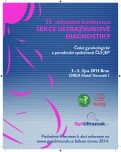Evolution of peripartal hysterectomy at our department – five years evaluations
Authors:
E. Pálová; A. Maľová; Ľ. Hammerová; M. Redecha
Authors‘ workplace:
I. gynekologicko-pôrodnícka klinika LF UK a UN, Bratislava, prednosta prof. MUDr. M. Borovský, CSc.
Published in:
Ceska Gynekol 2014; 79(3): 175-178
Overview
The purpose of this study was to determine the frequency, indications, complications and risk factors associated with peripartum hysterectomy carried out at our clinical department between 1st January 2008 and 31th December 2012. Peripartum hysterectomy was defined as a hysterectomy performed less than 48 hours after delivery. Clinical characteristic and obstetric histories were retrospectively reviewed between 5 years. There were 20 emergency peripartum hysterectomies among 13 660 deliveries at our department. The overall rate of peripartum hysterectomy was 1,46 per 1000 deliveries. The primary indications for hysterectomy were uncontrolled bleeding caused by uterine hypotony (45%), followed by placenta praevia (25%). Other indications were placental abruption (15%), pelvic endometriosis (5%), placenta increta (5%) and uterus myomatosus (5 %). The incidence of peripartum hysterectomy increased 2-fold in cases of placental patology, and 17-fold in cases of uterine hypotony. Overall, 95% of hysterectomy patients required transfusions.
Keywords:
peripartum hysterectomy, postpartum haemorrhage
Sources
1. Baskett, TF. Emergency obstetric hysterectomy. J Obstet Gynaecol, 2003, 23, p. 353–355.
2. Bateman, BT., Mhyre, JM., Callaghan, WM., et al. Peripartum hysterectomy in the United States: nationwide 14 year experience. Am J Obstet Gynecol, 2012, 206, 63 p.
3. Bodelon, C., Bernabe-Ortiz, A., Schiff, MA., et al. Factors associated with peripartum hysterectomy. Obstet Gynecol, 2009, 114, p. 115–123.
4. Briery, CM., Rose, CH., Hudson, WT., et al. Planned vs emergent cesarean hysterectomy. Am J Obstet Gynecol, 2007, 197,154 p.
5. www.europeristat.com
6. Glaze, S., Ekwalanga, P., Roberts, G., et al. Peripartum hysterectomy: 1999 to 2006. Obstet Gynecol, 2008, 111, p. 732–738.
7. Kacmar, ES., Bhimani, L., Boyd, M., et al. Route of delivery as a risk factor for emergent peripartum hysterectomy: a case – control study. Obstet Gynecol, 2003, 102, p. 141–145.
8. Knight, M. Peripartum hysterectomy in the UK: management and outcomes of the associated haemorrhage. BJOG, 2007, 114, p. 1380–1387.
9. Korbeľ, M., Borovský, M., Danko, J., et al. Analýza perinatologických výsledkov Slovenskej republiky v rokoch 2007–2009. Čes Gynek, 2011, 76, s. 18–24.
10. Korbeľ, M., Borovský, M., Danko, J., et al. Analýza perinatálnych výsledkov Slovenskej republiky za rok 2011. Gynekol Prax, 2013, 11, s. 20–24.
11. Kwee, A., Bots, ML., Visser, GH., et al. Emergency peripartum hysterectomy: a prospective study in The Netherlands. Eur J Obstet Gynecol Reprod Biol, 2006, 124, p. 187–192.
12. Omole-Ohonsi, A., Olayinka, HT. Emergency peripartum hysterectomy in a developing country. J Obstet Gynaecol Can, 2012, 34, p. 954–960.
13. Parazzini, F., Ricci, E., Cipriani, S., et al. Temporal trends and determinants of peripartum hysterectomy in Lombardy, Northern Italy, 1996–2010. Arch Gynecol Obstet, 2013, 287, p. 223–228.
14. Sheiner, E., Levy, A., Katz, M., et al. Identifying risk factors for peripartum cesarean hysterectomy. a population-based study. J Reprod Med, 2003, 48, p. 622–626.
15. Silver, RM., Landon, MB., Rouse, DJ., et al. Maternal morbidity associated with multiple repeat cesarean deliveries. Obstet Gynecol, 2006, 107, p. 1226–1232.
16. NCZISK (Národné centrum zdravotníckych informácií). Starostlivosť o ženu v SR 2002. Bratislava: NCZISK Edícia zdravotnícka štatistika, 2002.
17. Zeteroglu, S., Ustun, Y., Engin-Ustun, Y., et al. Peripartum hysterectomy in a teaching hospital in the eastern region of Turkey. Eur J Obstet Gynecol Reprod Biol, 2005, 120, p. 57–62. MUDr. Eva Pálová
Labels
Paediatric gynaecology Gynaecology and obstetrics Reproduction medicineArticle was published in
Czech Gynaecology

2014 Issue 3
Most read in this issue
- Diagnostic algorithm in pregnancies of uncertain viability or unknown location – a review of the latest recommendations
- Myo-inositol in the treatment of polycystic ovary syndrome
-
Prenatal diagnosis of skeletal dysplasia in first trimester of pregnancy
X-linked dominant chondrodysplasia punctata - HELLP syndrome complicated by liver rupture – case report
